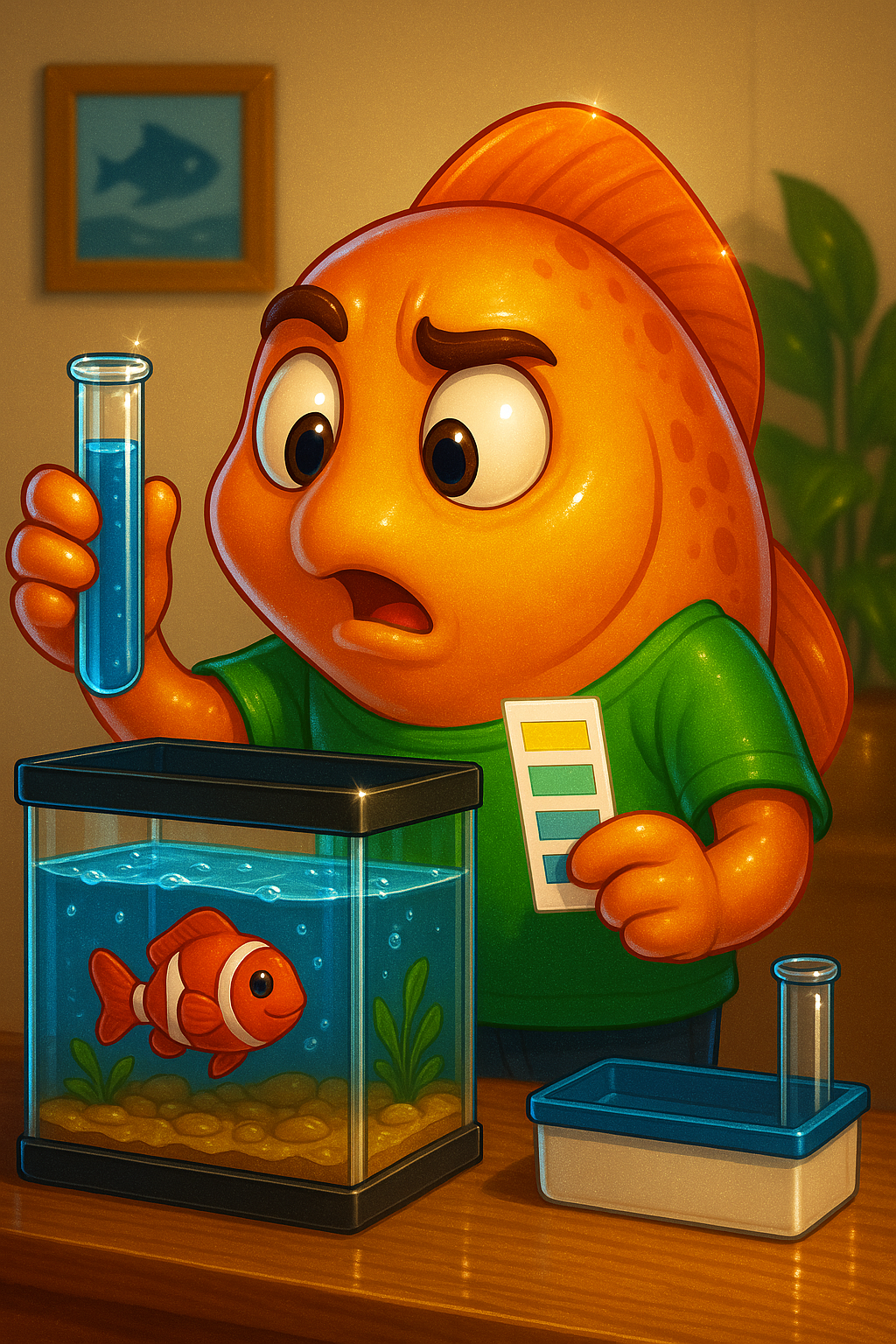Complete Guide: How to Test Aquarium Water Quality
🧪 Complete Guide: How to Test Aquarium Water Quality
Healthy fish depend on clean, stable water. Even if your tank looks clear, harmful substances may be present. Testing lets you catch problems before they hurt your fish.
📦 Types of Aquarium Water Test Kits
1. 🧴 Liquid Reagent Test Kits (Most Accurate)
- How it works: Add a set number of drops of chemical solution into a test tube with tank water, shake, and compare the color to a chart.
- Best for: Ammonia, nitrite, nitrate, and pH. Some kits also include GH (hardness) and KH (alkalinity).
- ✅ Pros: Accurate, affordable long-term, industry standard.
- ⚠️ Cons: Takes more time and handling.
Popular Example: API Freshwater Master Test Kit.
2. 📊 Test Strips (Fast & Convenient)
- How it works: Dip strip in tank water for a few seconds, compare colors after waiting briefly.
- Best for: Quick checks of pH, GH, KH, nitrite, nitrate.
- ✅ Pros: Fast and easy, especially for new hobbyists.
- ⚠️ Cons: Less precise; colors can fade or be hard to interpret.
3. 💻 Digital Testers & Electronic Meters
- How it works: Insert probe into water, get instant readings for specific values.
- Best for: pH, salinity, TDS (total dissolved solids), conductivity.
- ✅ Pros: Very accurate, instant numbers, easy to log data.
- ⚠️ Cons: Usually limited to one parameter (can’t test ammonia/nitrite/nitrate).
4. 🧬 Professional Lab Tests (Advanced)
- How it works: Send water sample to lab or local fish store.
- Best for: Detailed breakdowns including heavy metals, phosphate, copper.
- ✅ Pros: Extremely accurate, identifies hidden issues.
- ⚠️ Cons: Not practical for weekly use, usually for troubleshooting.
🔑 Key Water Parameters to Test & Safe Ranges
| Parameter | Safe Range (Most Fish) | Why It Matters |
|---|---|---|
| 💨 Ammonia (NH₃) | 0 ppm | Toxic even at trace levels; damages gills and organs. |
| 💨 Nitrite (NO₂⁻) | 0 ppm | Interferes with oxygen transport in blood (“brown blood disease”). |
| 💧 Nitrate (NO₃⁻) | <20–40 ppm (lower for sensitive fish, <10 ppm for fry/discus) | High levels stress fish, dull colors, weaken immune system. |
| ⚖️ pH | 6.5–7.5 (varies by species) | Stability is more important than exact value. |
| 🧂 GH (General Hardness) | 4–12 dGH for most freshwater fish | Measures calcium/magnesium; vital for bone & muscle health. |
| 🧱 KH (Carbonate Hardness) | 3–8 dKH for most fish | Buffers pH, prevents sudden swings. |
| 🌡️ Temperature | 72–82°F (22–28°C) depending on species | Keep stable; avoid rapid fluctuations. |
| 🧪 Phosphate (PO₄) | <0.5 ppm | High levels fuel algae growth. |
🕒 How Often to Test Aquarium Water
- 🚀 New Tanks (Cycling) → Test daily for ammonia, nitrite, nitrate until the cycle completes.
- 🐠 Established Tanks → Test weekly for ammonia, nitrite, nitrate, and pH.
- 🐡 Heavily Stocked Tanks → Test twice weekly, especially if nitrates rise quickly.
- 🌿 Planted Tanks → Test weekly for nitrate, phosphate, pH, KH to balance fertilization.
- 🐣 Breeding & Fry Tanks → Test daily or every other day (fry are highly sensitive).
📝 Step-by-Step Routine: Testing Aquarium Water
- Collect sample water in a clean cup or test tube.
- Use chosen method (liquid kit, strip, or meter).
- Liquid: add drops, shake, compare to chart.
- Strip: dip, wait, match colors.
- Meter: dip probe, read display.
- Record results in a notebook or app (track trends over time).
- Interpret results:
- Ammonia or nitrite above 0 ppm → immediate water change & check filtration.
- Nitrate above 40 ppm → increase water changes or reduce feeding.
- pH swings → check KH levels, avoid drastic shifts.
- Take action if outside safe ranges (water change, adjust stocking, buffer minerals, or improve filtration).
🧭 Troubleshooting with Test Results
- 🚫 High Ammonia → Tank not cycled, overfeeding, or filter issue. Fix: water change, stop overfeeding, check biofiltration.
- 🚫 High Nitrite → Cycle still maturing or filter crash. Fix: water changes + add beneficial bacteria supplement.
- 🚫 High Nitrate → Too much waste/feeding. Fix: larger or more frequent water changes, reduce stocking, add live plants.
- 🚫 Low KH (unstable pH) → Use crushed coral, aragonite, or KH buffer.
- 🚫 High GH (hard water) → Mix with RO (reverse osmosis) or distilled water.
- 🚫 High Phosphate → Reduce feeding, use phosphate removers, limit decaying organics.
🐟 Why Regular Testing Matters
- Fish often show stress after water goes bad → testing prevents hidden problems.
- Catching issues early avoids disease, fin rot, algae blooms, or fish deaths.
- Stable water = healthier fish, brighter colors, longer lifespans.
⚡ Golden Rule:
Don’t guess — always test. Clear water isn’t always clean water.

Powered by Lightspeed
Display prices in:USD